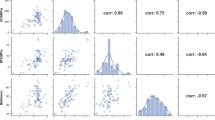Abstract
Machine chatter is still an unresolved and challenging issue in the milling process, and developing an online chatter identification and process monitoring system towards smart manufacturing is an urgent requirement. In this paper, two indicators of chatter detection are investigated. One is the real-time variance of milling force signals in the time domain, and the other one is the wavelet energy ratio of acceleration signals based on wavelet packet decomposition in the frequency domain. Then, a novel classification concept for vibration condition, called slight chatter, is proposed and integrated successfully into the designed multi-classification support vector machine (SVM) model. Finally, a mapping model between image and chatter indicators is established via a distance threshold on the image. The multi-SVM model is trained by the results of three signals as an input. Experiment data and detection accuracy of the SVM model are verified in actual machining. The identification accuracy of 96.66% has proved that the proposed solution is feasible and effective. The presented method can be used to select optimized milling parameters to improve machining process stability and strengthen manufacturing system monitoring.







Similar content being viewed by others
Abbreviations
- AE:
-
Acoustic emission
- ACC:
-
Auto-correlation coefficient
- ANN:
-
Artificial neural network
- BPNN-GA:
-
Back propagation neural network-genetic algorithm
- CIR:
-
Coarse-grained information rate
- CCD:
-
Charge coupled device
- CWT:
-
Continuous wavelet transform
- DFT:
-
Discrete Fourier transform
- DTF:
-
Disturbance transfer function
- DWT:
-
Discrete wavelet transform
- EA:
-
Envelope analysis
- ECDS:
-
Eddy current displacement sensor
- EE:
-
Energy entropy
- ER-PSD:
-
Energy ratio of power spectral density
- EMD:
-
Empirical mode decomposition
- EMHPM:
-
Enhanced multistage homotopy perturbation method
- EEMD:
-
Ensemble empirical mode decomposition
- FCM:
-
Fuzzy classification method
- FFT:
-
Fast Fourier transform
- Ga index:
-
Arithmetic average of gray level
- GLCM:
-
Gray-level co-occurrence matrix
- HHT:
-
Hilbert-huang transform
- LDE:
-
Linear differential equation
- LGDE:
-
Local gradient direction estimation
- MLP:
-
Multi-layer perceptron
- OVMD:
-
Optimized variational mode decomposition
- PE:
-
Permutation entropy
- PFD:
-
Peak force density
- PSD:
-
Power spectral density
- PSE:
-
Power spectral entropy
- RBF:
-
Radial basis function
- RTVF:
-
Real-time variance of force
- SA:
-
Synchronous averaging
- SAA:
-
Simulated annealing algorithm
- SAFT:
-
Short angular Fourier transform
- SLD:
-
Stability lobe diagram
- SST:
-
Synchro squeezing transform
- STFT:
-
Short-time Fourier transform
- SVD:
-
Singular value decomposition
- SVM:
-
Support vector machine
- UCL:
-
Upper confidence limit
- VMD:
-
Variational mode decomposition
- WPD:
-
Wavelet packet decomposition
- WVT:
-
Wigner-ville transformation
- WTMM:
-
Wavelet transform modulus maxima
References
Yue C, Gao H, Liu X et al (2019) A review of chatter vibration research in milling. Chin J Aeronaut 32(2):215–242
Munoa J, Beudaert X, Dombovari Z et al (2016) Chatter suppression techniques in metal cutting. CIRP Ann-Manuf Technol 65(2):785–808
Quintana G, Ciurana J (2011) Chatter in machining processes: A review. Int J Mach Tool Manuf 51(5):363–376
Altintas Y, Weck M (2004) Chatter stability of metal cutting and grinding. CIRP Ann-Manuf Technol 53(2):619–642
Olvera D, Elías-Zúñiga A, Martínez-Alfaro H et al (2014) Determination of the stability lobes in milling operations based on homotopy and simulated annealing techniques. Mechatronics 24(3):177–185
Lamraoui M, Thomas M, EI Badaoui M et al (2014) Indicators for monitoring chatter in milling based on instantaneous angular speeds. Mech Syst Signal Process 44(1/2):72–85
Lamraoui M, Thomas M, EI Badaoui M (2014) Cyclostationarity approach for monitoring chatter and tool wear in high speed milling. Mech Syst Signal Process 44(1/2):177–198
Aslan D, Altintas Y (2018) On-line chatter detection in milling using drive motor current commands extracted from CNC. Int J Mach Tool Manuf 132:64–80
Altintas Y, Aslan D (2017) Integration of virtual and on-line machining process control and monitoring. CIRP Ann-Manuf Technol 66(1):349–352
Devillez A, Dudzinski D (2007) Tool vibration detection with eddy current sensors in machining process and computation of stability lobes using fuzzy classifiers. Mech Syst Signal Process 21(1):441–456
Albertelli P, Braghieri L, Torta M et al (2019) Development of a generalized chatter detection methodology for variable speed machining. Mech Syst Signal Process 123:26–42
Szydłowski M, Powałka B (2012) Chatter detection algorithm based on machine vision. Int J Adv Manuf Technol 62(5/8):517–528
Lei N, Soshi M (2017) Vision-based system for chatter identification and process optimization in high-speed milling. Int J Adv Manuf Technol 89(9/12):2757–2769
Chen Y, Li H, Jing X et al (2019) Intelligent chatter detection using image features and support vector machine. Int J Adv Manuf Technol 102(5/8):1433–1442
Kuljanic E, Sortino M, Totis G (2008) Multisensor approaches for chatter detection in milling. J Sound Vib 312(4):672–693
Kuljanic E, Totis G, Sortino M (2009) Development of an intelligent multisensor chatter detection system in milling. Mech Syst Signal Process 23(5):1704–1718
Wang L, Liang M (2009) Chatter detection based on probability distribution of wavelet modulus maxim. Rob Comput-Integr Manuf 25(6):989–998
Yao Z, Mei D, Chen Z (2010) On-line chatter detection and identification based on wavelet and support vector machine. J Mater Process Technol 210(5):713–719
Cao H, Lei Y, He Z (2013) Chatter identification in end milling process using wavelet packets and Hilbert-Huang transform. Int J Mach Tool Manuf 69:11–19
Lamraoui M, Barakat M, Thomas M et al (2015) Chatter detection in milling machines by neural network classification and feature selection. J Vib Control 21(7):1251–1266
Qu S, Zhao J, Wang T (2016) Three-dimensional stability prediction and chatter analysis in milling of thin-walled plate. Int J Adv Manuf Technol 86(5/8):2291–2300
Burtscher J, Fleischer J (2017) Adaptive tuned mass damper with variable mass for chatter avoidance. CIRP Ann-Manuf Technol 66(1):397–400
Friedrich J, Hinze C, Renner A et al (2017) Estimation of stability lobe diagrams in milling with continuous learning algorithms. Rob Comput-Integr Manuf 43:124–134
Cao H, Zhou K, Chen X (2015) Chatter identification in end milling process based on EEMD and nonlinear dimensionless indicators. Int J Mach Tool Manuf 92:52–59
Cao H, Yue Y, Chen X et al (2017) Chatter detection in milling process based on synchrosqueezing transform of sound signals. Int J Adv Manuf Technol 89(9/12):2747–2755
Liu J, Hu Y, Wu B et al (2017) A hybrid health condition monitoring method in milling operations. Int J Adv Manuf Technol 92:2069–2080
Gradisek J, Baus A, Govekar E et al (2003) Automatic chatter detection in grinding. Int J Mach Tool Manuf 43:1397–1403
Nair U, Krishna BM, Namboothiri VNN et al (2010) Permutation entropy based real-time chatter detection using audio signal in turning process. Int J Adv Manuf Technol 46(1/4):61–68
Shi J, Song Q, Liu Z et al (2017) A novel stability prediction approach for thin-walled component milling considering material removing process. Chin J Aeronaut 30(5):1789–1798
Khalifa OO, Densibali A, Faris W (2006) Image processing for chatter identification in machining processes. Int J Adv Manuf Technol 31(5/6):443–449
Kim SK, Lee SY (2001) Chatter prediction of end milling in a vertical machining center. J Sound Vib 241(4):567–586
Peng C, Wang L, Liao TW (2015) A new method for the prediction of chatter stability lobes based on dynamic cutting force simulation model and support vector machine. J Sound Vib 354:118–131
Cabrera CG, Anna CA, Daniel AC (2017) On the wavelet analysis of cutting forces for chatter identification in milling. Adv Manuf 5(2):130–142
Zhang Z, Li H, Meng G et al (2016) Chatter detection in milling process based on the energy entropy of VMD and WPD. Int J Mach Tool Manuf 108:106–112
Liu C, Zhu L, Ni C (2017) The chatter identification in end milling based on combining EMD and WPD. Int J Adv Manuf Technol 91(9/12):3339–3348
Liu C, Zhu L, Ni C (2018) Chatter detection in milling process based on VMD and energy entropy. Mech Syst Signal Process 105:169–182
Yang K, Wang G, Dong Y et al (2019) Early chatter identification based on an optimized variational mode decomposition. Mech Syst Signal Process 115:238–254
Acknowledgements
Authors acknowledge the support from the National Key R&D Program of China (Grant No. 2017YFE0101400), and also appreciate reviewers for their critical comments.
Author information
Authors and Affiliations
Corresponding author
Rights and permissions
About this article
Cite this article
Li, DD., Zhang, WM., Li, YS. et al. Chatter identification of thin-walled parts for intelligent manufacturing based on multi-signal processing. Adv. Manuf. 9, 22–33 (2021). https://doi.org/10.1007/s40436-020-00299-x
Received:
Revised:
Accepted:
Published:
Issue Date:
DOI: https://doi.org/10.1007/s40436-020-00299-x




